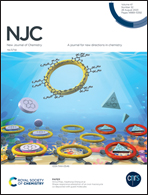Highly active higher coordinated copper(i)–N-heterocyclic chalcogenone catalysed click chemistry†
Abstract
The tri-coordinated and tetra-coordinated copper(I)–N-heterocyclic chalcogenone catalysed [3+2] cycloaddition reaction has been reported to understand the role of ancillary ligands and the coordination environment of the catalyst. A series of tri-coordinated mononuclear copper(I)–N-heterocyclic chalcogenone catalysts have been synthesised and structurally characterised along with a cationic tetra-coordinated mononuclear copper(I)–N-heterocyclic chalcogenone catalyst. These new catalysts were characterised by FT-IR, NMR, and single-crystal X-ray diffraction techniques. Subsequently, these catalysts were screened for [3+2] cycloaddition catalytic reaction between aryl azide and phenylacetylene. Interestingly, the tri-coordinated mononuclear catalysts consisting of bromo and iodo ligands depicted better catalytic performance compared to the chloro ligand coordinated catalysts. However, the tetra-coordinated ionic catalyst depicted excellent [3+2] cycloaddition catalytic activities compared to the neutral tri-coordinated Cu(I) halide complexes. The mechanistic study disclosed the crucial roles of a six-membered cyclic transition state of the copper(I) catalyst for high reactivity.



 Please wait while we load your content...
Please wait while we load your content...